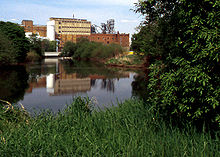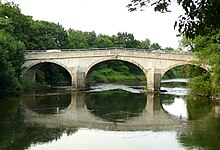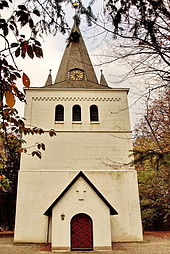Schulenburg (Pattensen)
|
Schulenburg
City of Pattensen
|
|
|---|---|
| Coordinates: 52 ° 11 ′ 42 ″ N , 9 ° 46 ′ 39 ″ E | |
| Height : | 78 m |
| Residents : | 2361 (Oct. 1, 2019) |
| Incorporation : | March 1, 1974 |
| Postal code : | 30982 |
| Area code : | 05069 |
Schulenburg is the southernmost and second largest district of the city of Pattensen in Lower Saxony after the core town and is located in the Calenberger Land directly on the Leine .
history
Various finds indicate settlement as early as the Stone Age. A chapel in Schulenburg was first mentioned in a document in 1282. In 1298 Schulenburg itself is mentioned in a document as a settlement. The sandstone bridge over the Leine is built in 1751.
The ruins of the Calenberg Fortress are located near Schulenburg, which still indicates the former importance of Schulenburg as the residence of the Guelph dukes. Duke Otto der Strenge built the castle against the bishops of Hildesheim at the end of the 13th century (mentioned in 1290 as "castrum calenberg") . It was destroyed in the Thirty Years War . Schulenburg was the seat of the Calenberg district until 1867 .
The Marienburg near Schulenburg was built between 1857 and 1867 by King George V for his wife Marie.
On March 1, 1974, the community Schulenburg (Leine) (official name) was incorporated into the city of Pattensen.
Gold jewelry discovery from 1911
The Schulenburg gold lunula was founded in April 1911 by the farmer's son Alten jun. found. This happened when clearing a forest in hallway 8 of Schulenburg. The find was exposed in the roots of a maple tree at a depth of 30 cm and then sold to the Hannover Provincial Museum . Since there was no follow-up investigation of the site, it remained unclear whether it was a grave find, a victim find or a custody find.
The find is one of the few gold lunulae that have been excavated in Germany and on the European mainland. It originated in the Early Bronze Age and was probably imported from Ireland at the time . This find near Adensen points to the extensive trade relations with Ireland that already existed at that time. Most of the gold lunulae have been found there; therefore Ireland is considered to be their place of manufacture. The original of the find is exhibited in the Lower Saxony State Museum in Hanover and a copy in the museum in the castle courtyard in Springe.
religion

The Protestant Thomas Church is located in Schulenburg, on Schulstrasse and today belongs to the Laatzen-Springe church district.
The Catholic Holy Cross Church from 1960 was profaned in 2012 . At last it belonged to the parish of the Holy Spirit with its seat in Sarstedt. Today the nearest Catholic church is in Nordstemmen, 7 km away .
In 1987 a New Apostolic Church was built on Hauptstrasse . In 2009 the New Apostolic church congregation was dissolved. The church building was sold and is now used by a company for the manufacture of ship lights.
politics
The local mayor is Svenja Blume (CDU).
Culture and sights
- Domain Calenberg
- Evangelical Thomas Church
- Sandstone bridge over the Leine from 1751.
- Ruins of the fortress Calenberg
- Marienburg Castle
See also the list of architectural monuments in Schulenburg
Important school burghers
- Annalena Baerbock (* 1980), Federal Chairwoman of Bündnis 90 / Die Grünen since January 2018
literature
- Eckard Steigerwald: Pattensen. On the history and development of the villages (until the end of the 16th century). Publication and distribution: Stadt Pattensen 1986, OCLC 844044794 .
Web links
Individual evidence
- ^ Pattensen in numbers + dates. In: Website of the city of Pattensen. October 1, 2019, accessed October 20, 2019 .
- ^ Federal Statistical Office (ed.): Historical municipality directory for the Federal Republic of Germany. Name, border and key number changes in municipalities, counties and administrative districts from May 27, 1970 to December 31, 1982 . W. Kohlhammer, Stuttgart / Mainz 1983, ISBN 3-17-003263-1 , p. 202 .
-
^ Sources:
1) Hans Hahne: The gold jewelry from Schulenburg. In: JB Provinzial-Museum Hannover. 1911/12, p. 86ff.
2) Early gold. Prehistoric and early historical gold finds from Lower Saxony. (Find stories and cultural-historical impressions) Lower Saxony State Museum Hanover. Isensee Verlag, Oldenburg 2003, ISBN 3-89995-066-6 , pp. 31-34.
3) Hans-Jürgen Häßler: Prehistory and early history in Lower Saxony . Nikol Verlagsgesellschaft, Hamburg 2002, p. 501.
4) Eckard Steigerwald: Pattensen. On the history and development of the villages (up to the end of the 16th century) Publication and distribution: Stadt Pattensen 1986, p. 15f.




